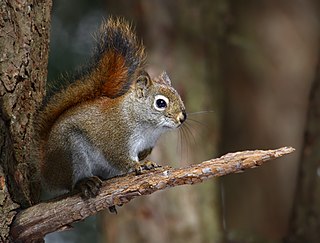 W
WThe American red squirrel is one of three species of tree squirrels currently classified in the genus Tamiasciurus, known as the pine squirrels. The American red squirrel is variously known as the pine squirrel, North American red squirrel and chickaree. It is also referred to as Hudson's Bay squirrel, as in John James Audubon's work The Viviparous Quadrupeds of North America. The squirrel is a small, 200–250 g (7.1–8.8 oz), diurnal mammal that defends a year-round exclusive territory. It feeds primarily on the seeds of conifer cones, and is widely distributed across North America wherever conifers are common, except on the Pacific coast, where its cousin, the Douglas squirrel, is found instead. The American red squirrel is not found on most of the Great Plains or in the southeastern United States, except for the Blue Ridge Mountains, as conifer trees are not common in those areas.
 W
WThe Atlantic jackknife clam, Ensis leei, also known as the bamboo clam, American jackknife clam or razor clam, is a large edible marine bivalve mollusc found on the North American Atlantic coast, from Canada to South Carolina. The species has also been introduced to Europe. The name "razor clam" is also used to refer to different species such as the Pacific razor clam or Razor shell.
 W
WThe Atlantic surf clam, also called the bar clam, hen clam, skimmer or simply sea clam, is a very large, edible, saltwater clam or marine bivalve mollusk in the family Mactridae. It is commonly found in the western Atlantic Ocean. Reaching up to 20 centimetres (7.9 in) or more in length, it is much larger than Spisula solida, which resides in the eastern Atlantic waters off of Great Britain.
 W
WThe smallmouth bass is a species of freshwater fish in the sunfish family (Centrarchidae) of the order Perciformes. It is the type species of its genus. One of the black basses, it is a popular game fish sought by anglers throughout the temperate zones of North America, and has been spread by stocking—as well as illegal introductions—to many cool-water tributaries and lakes in Canada and more so introduced in the United States. The maximum recorded size is approximately 27 inches and 12 pounds. The smallmouth bass is native to the upper and middle Mississippi River basin, the Saint Lawrence River–Great Lakes system, and up into the Hudson Bay basin.The world record size was over 11 pounds caught in the lake Dale Hollow, on the Kentucky—Tennessee border. Its common names include smallmouth, bronzeback, brown bass, brownie, smallie, bronze bass, and bareback bass.
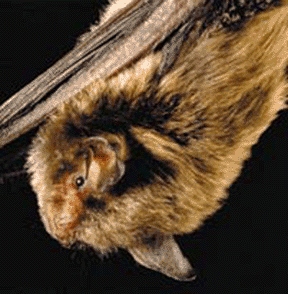 W
WThe Indiana bat is a medium-sized mouse-eared bat native to North America. It lives primarily in Southern and Midwestern U.S. states and is listed as an endangered species. The Indiana bat is gray, black, or chestnut in color and is 1.2–2.0 in long and weighs 4.5–9.5 g (0.16–0.34 oz). It is similar in appearance to the more common little brown bat, but is distinguished by its feet size, toe hair length, pink lips, and a keel on the calcar.
 W
WThe cinnamon bear is both a highly variable color morph and a subspecies of the American black bear, native to the central and western areas of the United States and Canada. Established populations are found in Colorado, New Mexico, Utah, Idaho, Montana, Washington, Manitoba, Minnesota, Wisconsin, Wyoming, California, Alberta, Ontario, and British Columbia. They also have been seen in Pennsylvania, Tennessee, Quebec, and New York, and therefore as a subspecies, most likely exist alongside the mostly black-colored eastern American black bears present in both states, and breed with them. The most striking difference between a cinnamon bear and any other black bear is its brown or red-brown fur, reminiscent of cinnamon. The subspecies was given this designation because the lighter color phase is more common there than in other areas.
 W
WThis list of birds of New York includes the 494 species and a species pair of wild birds documented in New York as of July 2020. Unless noted otherwise, the source is the Checklist of New York State Birds published by the New York State Avian Records Committee (NYSARC) of the New York State Ornithological Association. These species represent 23 orders and 67 families of birds. An additional, "hypothetical", species is also noted by NYSARC.
 W
WThe Atlantic cod is a benthopelagic fish of the family Gadidae, widely consumed by humans. It is also commercially known as cod or codling. Dry cod may be prepared as unsalted stockfish, as cured salt cod or clipfish.
 W
WThe creek chubsucker is a freshwater fish of the sucker family (Catostomidae).
 W
WDesmognathus fuscus is a species of amphibian in the family Plethodontidae. The species is commonly called the dusky salamander or northern dusky salamander to distinguish it from populations in the southern United States which form a separate species, the southern dusky salamander. The northern dusky salamander is the most widespread representative of its genus in Canada. It can be found in eastern North America from extreme eastern Canada in New Brunswick south into the panhandle of Florida and west to Louisiana. The size of the species' total population is unknown, but is assumed to easily exceed 100,000. The species' habitat differs somewhat geographically; dusky salamanders in the northern part of the range prefer rocky woodland streams, seepages, and springs, while those in the south favor floodplains, sloughs, and muddy places along upland streams. They are most common where water is running or trickling. They hide under various objects, such as leaves or rocks, either in or near water. Alternatively, they may enter burrows for protection. The dusky salamander lays its eggs close to water under moss or rocks, in logs, or in stream-bank cavities. The larval stage which follows is normally aquatic.
 W
WThe seal salamander is a species of lungless salamander that is endemic to the Eastern United States.
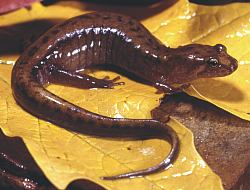 W
WThe Allegheny Mountain dusky salamander is a species in the Plethodontidae family. It is found in the eastern United States and southern Quebec, Canada. Its natural habitats are temperate forests, rivers, intermittent rivers, freshwater springs, and rocky areas.
 W
WThe eastern newt is a common newt of eastern North America. It frequents small lakes, ponds, and streams or nearby wet forests. The eastern newt produces tetrodotoxin, which makes the species unpalatable to predatory fish and crayfish. It has a lifespan of 12 to 15 years in the wild, and it may grow to 5 in (13 cm) in length. These animals are common aquarium pets, being either collected from the wild or sold commercially. The striking bright orange juvenile stage, which is land-dwelling, is known as a red eft. Some sources blend the general name of the species and that of the red-spotted newt subspecies into the eastern red-spotted newt.
 W
WEnallagma pictum, the scarlet bluet, is a species of damselfly in the family Coenagrionidae. They are found from New Brunswick, Canada to Maryland.
 W
WThe American smooth flounder is a flatfish of the family Pleuronectidae. It is a demersal fish that inhabits shallow inshore salt and brackish waters at depths of up to 27 metres (89 ft). Its native habitat is the temperate waters of the northwestern Atlantic, from Ungava Bay in Quebec, Canada to Rhode Island, United States. It can grow up to 30 centimetres (12 in) in length.
 W
WThe yellowtail flounder is a species of fish in the family Pleuronectidae. It is found in the western North Atlantic from southern Labrador to Chesapeake Bay.
 W
WThe mink frog is a small species of frog native to the United States and Canada. They are so named for their scent, which reportedly smells like a mink. The scent is more akin to that of rotting onions to those unfamiliar with mink. It is also sometimes referred to as the north frog.
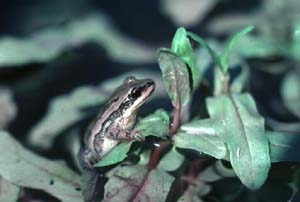 W
WThe upland chorus frog is a species of chorus frog found in the United States. It was recently separated from the Western chorus frog,, being identified as an individual species rather than a subspecies.
 W
WThe groundhog, also known as a woodchuck, is a rodent of the family Sciuridae, belonging to the group of large ground squirrels known as marmots. The groundhog is a lowland creature of North America; it is found through much of the eastern United States, across Canada and into Alaska. It was first scientifically described by Carl Linnaeus in 1758.
 W
WThe spring salamander is a species of salamander in the family Plethodontidae It is found in Canada and the United States. The generic name, Gyrinophilus, means "tadpole lover" and refers to the long period of time it spends as a gilled larva before maturing. The specific name, porphyriticus, is Latin from Greek, meaning the color of porphyry, a purple stone, and this salamander has also been called the purple salamander.
 W
WThe hard clam, also known as a quahog, round clam or hard-shell clam, is an edible marine bivalve mollusk that is native to the eastern shores of North America and Central America from Prince Edward Island to the Yucatán Peninsula. It is one of many unrelated edible bivalves that in the United States are frequently referred to simply as clams, as in the expression "clam digging". Older literature sources may use the systematic name Venus mercenaria; this species is in the family Veneridae, the venus clams.
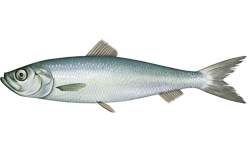 W
WAtlantic herring is a herring in the family Clupeidae. It is one of the most abundant fish species in the world. Atlantic herrings can be found on both sides of the Atlantic Ocean, congregating in large schools. They can grow up to 45 centimetres (18 in) in length and weigh up to 1.1 kilograms (2.4 lb). They feed on copepods, krill and small fish, while their natural predators are seals, whales, cod and other larger fish.
 W
WThe banded killifish is a North American species of temperate freshwater killifish belonging to the genus Fundulus of the family Fundulidae. Its natural geographic range extends from Newfoundland to South Carolina, and west to Minnesota, including the Great Lakes drainages. This species is the only freshwater killifish found in the northeastern United States. While it is primarily a freshwater species, it can occasionally be found in brackish water.
 W
WThe southern bog lemming is a small North American lemming. Its range overlaps with the other species in genus Synaptomys, the northern bog lemming, in southeastern Canada, but extends further south.
 W
WThe brindled madtom is a small catfish of the family Ictaluridae that is native to the eastern United States.
 W
WThe hairy-tailed mole, also known as Brewer's mole, is a medium-sized North American mole. It is the only member of the genus Parascalops. The species epithet breweri refers to Thomas Mayo Brewer, an American naturalist.
 W
WThe mummichog is a small killifish found along the Atlantic coast of the United States and Canada. Also known as Atlantic killifish, mummies, gudgeons, and mud minnows, these fish inhabit brackish and coastal waters including estuaries and salt marshes. The species is noted for its hardiness and ability to tolerate highly variable salinity, temperature fluctuations from 6 to 35 °C, very low oxygen levels, and heavily polluted ecosystems. As a result, the mummichog is a popular research subject in embryological, physiological, and toxicological studies. It is also the first fish ever sent to space, aboard Skylab in 1973.
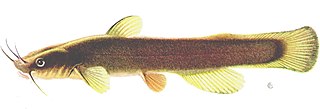 W
WNoturus insignis is a small species of North American catfish belonging to the family Ictaluridae.
 W
WThe Virginia opossum, commonly known as the North American opossum, is the only marsupial found north of Mexico. In the United States, the animal is typically referred to simply as a possum. It is a solitary and nocturnal animal about the size of a domestic cat. It is a successful opportunist. It is familiar to many North Americans as they frequently inhabit settled areas due to the associated proximity to food sources, notably trash cans.
 W
WThe chain pickerel is a species of freshwater fish in the pike family of order Esociformes. The chain pickerel and the American pickerel belong to the Esox genus of pike.
 W
WThe redfin pickerel is a subspecies of freshwater fish belonging to the pike family (Esocidae) of the order Esociformes. Not to be confused with its close relatives, the grass pickerel and the chain pickerel, this fish is unique in the fact that it has brightly colored red fins. Like all pikes, the redfin pickerel is an ambush predator, lying amongst thick vegetation in wait for smaller, more agile prey to enter within its range of attack.
 W
WThe American plaice, American sole or long rough dab is a North Atlantic flatfish that belongs, along with other right-eyed flounders, to the family Pleuronectidae. In the northwest Atlantic it ranges from Greenland and Labrador to Rhode Island, and in the northeast Atlantic it ranges from Murmansk to the English Channel, Ireland and Iceland. They live on soft bottoms at depths of 10 to 3,000 m (33–9,843 ft), but mainly between 90 and 250 m (300–820 ft).
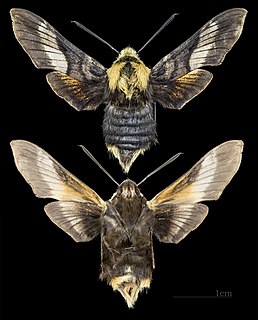 W
WProserpinus flavofasciata, the yellow-banded day sphinx, is a species of hawk moth which occurs at the edges of, and in clearings in, boreal and mountain forests across Canada, as far south as Maine and Massachusetts in the east and as far north as Alaska in the west. It is much commoner in the west of its range.
 W
WRats in New York City are widespread, as they are in many densely populated areas. For a long time, the number of rats in New York City was unknown, and a common urban legend declared there were up to five times as many rats as people. In 2014, however, scientists more accurately measured the entire city's rat population to be approximately only 24% of the number of humans. That would equate to approximately 2 million rats to New York's 8.4 million people at the time of the study.
 W
WRossia palpebrosa, also known as the warty bobtail squid, is a species of bobtail squid native to the northern Atlantic Ocean.
 W
WThe Allegheny Mountain dusky salamander is a species in the Plethodontidae family. It is found in the eastern United States and southern Quebec, Canada. Its natural habitats are temperate forests, rivers, intermittent rivers, freshwater springs, and rocky areas.
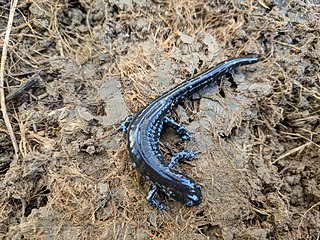 W
WThe blue-spotted salamander is a mole salamander native to the Great Lakes states and northeastern United States, and parts of Ontario and Quebec in Canada. Their range is known to extend to James Bay to the north, and southeastern Manitoba to the west.
 W
WThe four-toed salamander is a lungless salamander native to eastern North America. It is the only species of the monotypic genus Hemidactylium.
 W
WThe Jefferson salamander is a mole salamander native to the northeastern United States, southern and central Ontario, and southwestern Quebec. It was named after Jefferson College in Pennsylvania.
 W
WDesmognathus fuscus is a species of amphibian in the family Plethodontidae. The species is commonly called the dusky salamander or northern dusky salamander to distinguish it from populations in the southern United States which form a separate species, the southern dusky salamander. The northern dusky salamander is the most widespread representative of its genus in Canada. It can be found in eastern North America from extreme eastern Canada in New Brunswick south into the panhandle of Florida and west to Louisiana. The size of the species' total population is unknown, but is assumed to easily exceed 100,000. The species' habitat differs somewhat geographically; dusky salamanders in the northern part of the range prefer rocky woodland streams, seepages, and springs, while those in the south favor floodplains, sloughs, and muddy places along upland streams. They are most common where water is running or trickling. They hide under various objects, such as leaves or rocks, either in or near water. Alternatively, they may enter burrows for protection. The dusky salamander lays its eggs close to water under moss or rocks, in logs, or in stream-bank cavities. The larval stage which follows is normally aquatic.
 W
WThe northern slimy salamander is a species of terrestrial plethodontid salamander found throughout much of the eastern two-thirds of the United States.
 W
WThe northern two-lined salamander is a species of salamander in the family Plethodontidae found in Canada and the United States. Its natural habitats are temperate forests, temperate shrubland, rivers, intermittent rivers, freshwater marshes, freshwater springs, arable land, and urban areas. It is more water-oriented than the related northern redback salamander, and can often be found in and around water such as rain puddles, streams, swamps, and damp stream beds, whereas the northern redback tends to be found in damp ground, but usually not near open water.
 W
WThe red-backed salamander is a species of small, hardy woodland salamander in the family Plethodontidae. The species inhabits wooded slopes in eastern North America, west to Missouri, south to North Carolina, and north from southern Quebec and the Maritime provinces in Canada to Minnesota. It is also known as the redback salamander, eastern red-backed salamander, or the northern red-backed salamander to distinguish it from the southern red-backed salamander. It is one of 56 species in the genus Plethodon.
 W
WThe seal salamander is a species of lungless salamander that is endemic to the Eastern United States.
 W
WThe spotted salamander or yellow-spotted salamander is a mole salamander common in eastern United States and Canada. The spotted salamander is the state amphibian of Ohio and South Carolina. This salamander ranges from Nova Scotia, to Lake Superior, to southern Georgia and Texas. Its embryos have been found to have symbiotic algae living inside them, the only known example of vertebrate cells hosting an endosymbiont microbe.
 W
WThe spring salamander is a species of salamander in the family Plethodontidae It is found in Canada and the United States. The generic name, Gyrinophilus, means "tadpole lover" and refers to the long period of time it spends as a gilled larva before maturing. The specific name, porphyriticus, is Latin from Greek, meaning the color of porphyry, a purple stone, and this salamander has also been called the purple salamander.
 W
WThe Atlantic salmon is a species of ray-finned fish in the family Salmonidae which is the largest salmon and can grow up to a meter in length. It is found in the northern Atlantic Ocean and in rivers that flow into this ocean. Most populations of this fish species are anadromous, hatching in streams and rivers but moving out to sea as they grow where they mature, after which the adult fish seasonally move upstream again to spawn.
 W
WThe golden shiner is a cyprinid fish native to eastern North America. It is the sole member of its genus. Much used as a bait fish, it is probably the most widely pond-cultured fish in the United States. It can be found in Quebec and its French name is "Mené jaune" or "Chatte de l'Est".
 W
WThe long-tailed shrew or rock shrew is a small North American shrew found in Atlantic Canada and the Northeastern United States.
 W
WThe barndoor skate is a species of marine cartilaginous fish in the skate family Rajidae of the order Rajiformes. It is native to the northwestern Atlantic Ocean, and is found from the Grand Banks of Newfoundland and the southern side of the Gulf of St. Lawrence south to North Carolina. The fish is one of the largest skates found in the North Atlantic Ocean, reaching lengths up to 1.5 m (5 ft). It is carnivorous, feeding on invertebrates and other fish found near the sea floor.
 W
WThe little skate is a species of skate in the family Rajidae, found from Nova Scotia to North Carolina on sand or gravel habitats. They are one of the dominant members of the demersal fish community in the northwestern Atlantic. This species is of minimal commercial importance and is mostly used as bait for lobster traps, though its wings are also marketed for food. It is also important as a model organism for biological and medical research.
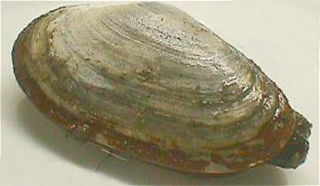 W
WSoft-shell clams or sand gaper, scientific name Mya arenaria, popularly called "steamers", "softshells", "piss clams", "Ipswich clams", or "Essex clams" are a species of edible saltwater clam, a marine bivalve mollusk in the family Myidae.
 W
WThe spring peeper is a small chorus frog widespread throughout the eastern United States and Canada. They are so called because of their chirping call that marks the beginning of spring. There are two subspecies:The northern, P. c. crucifer, found all over the eastern United States and eastern Canada. The southern, P. c. bartramiana. The southern is distinguished by a strong dark marking on its belly. P. c. bartramiana is found along the southern Gulf Coast from southeastern Texas to northern Florida and southern Georgia.
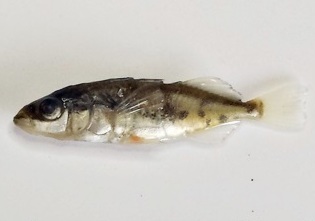 W
WThe blackspotted stickleback is a fish species, found in the western Atlantic from the coasts of Newfoundland (Canada) to Massachusetts. Brackishwater / marine benthic fish, up to 7.5 cm length.
 W
WThe three-spined stickleback is a fish native to most inland coastal waters north of 30°N. It has long been a subject of scientific study for many reasons. It shows great morphological variation throughout its range, ideal for questions about evolution and population genetics. Many populations are anadromous and very tolerant of changes in salinity, a subject of interest to physiologists. It displays elaborate breeding behavior and it can be social making it a popular subject of enquiry in fish ethology and behavioral ecology. Its antipredator adaptations, host-parasite interactions, sensory physiology, reproductive physiology, and endocrinology have also been much studied. Facilitating these studies is the fact that the three-spined stickleback is easy to find in nature and easy to keep in aquaria.
 W
WThe gray treefrog is a species of small arboreal holarctic tree frog native to much of the eastern United States and southeastern Canada.